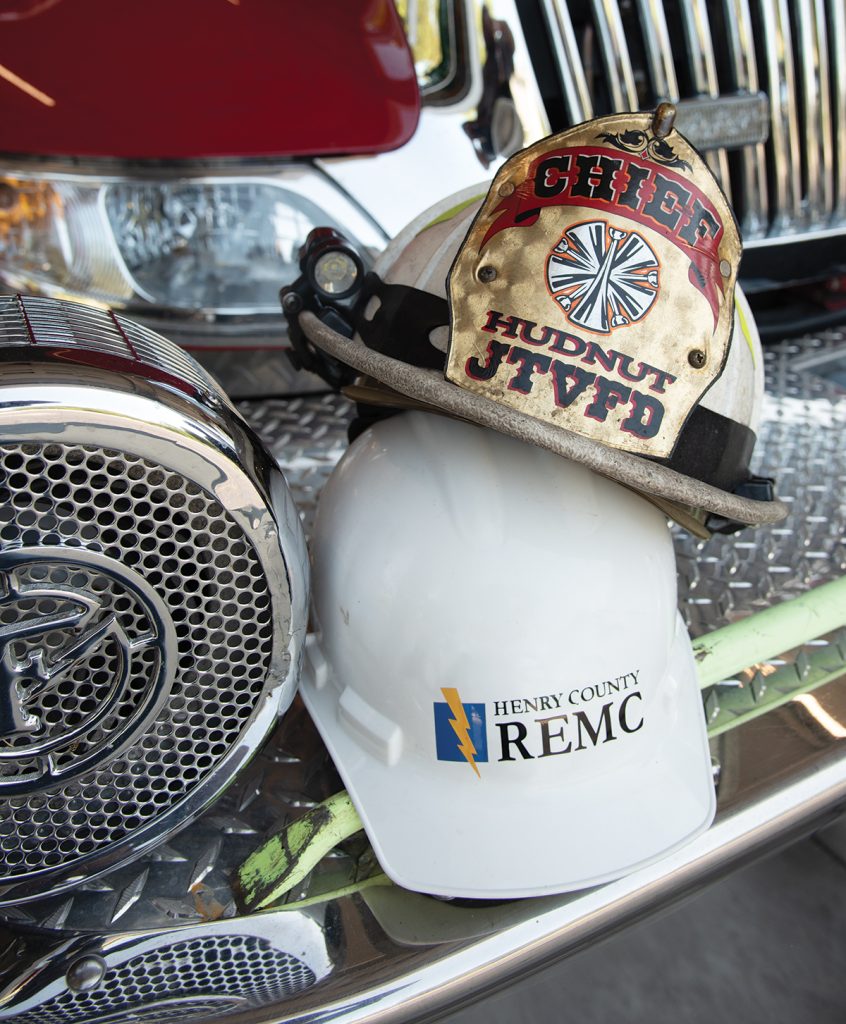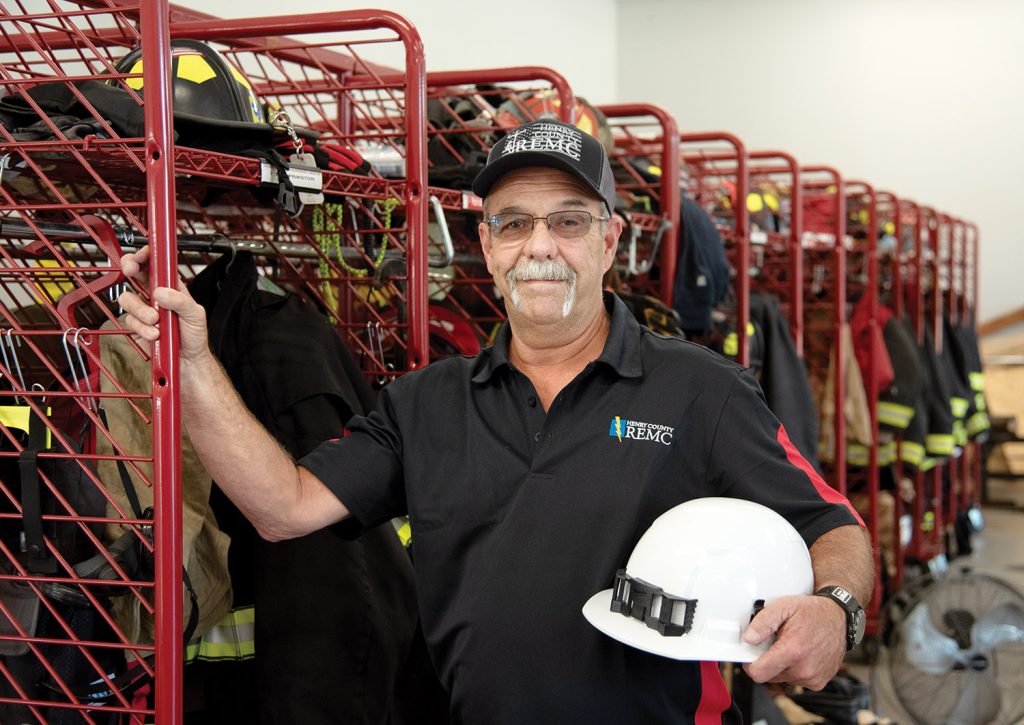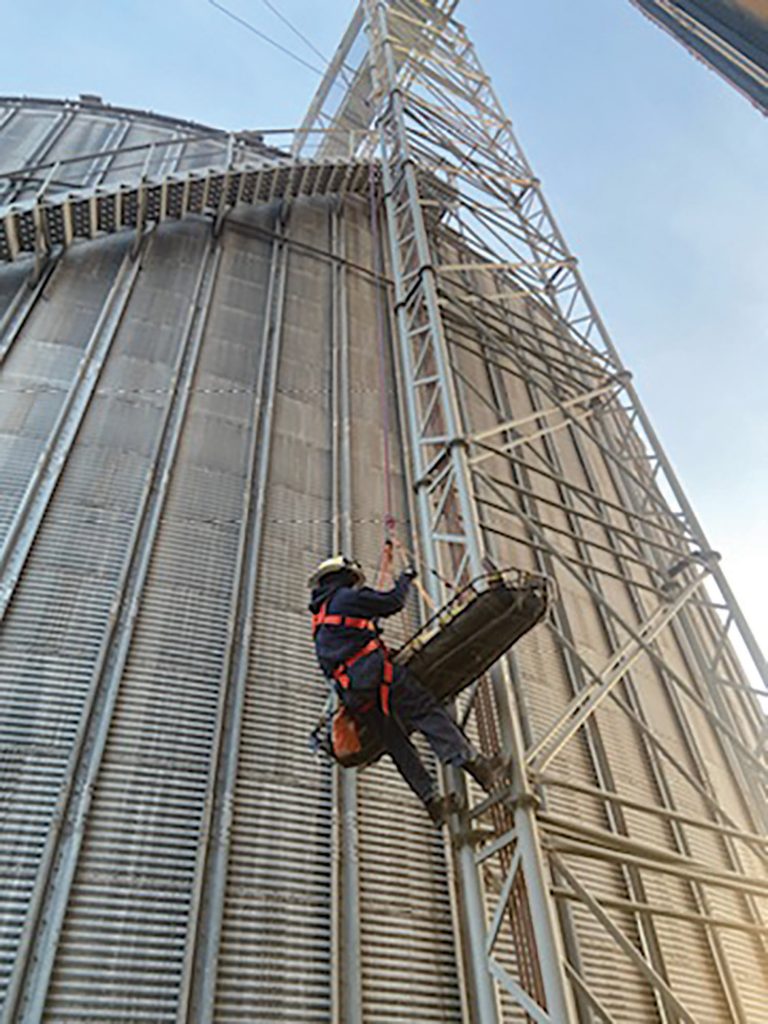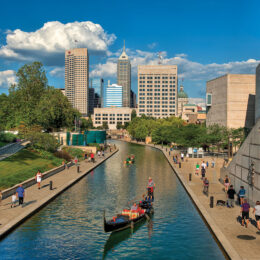Sometimes when Heath Hudnut is on his riding mower cutting grass on weekends or in the evening, his wife must flag him down. An emergency call has come in, and he needs to grab his white hat and go.
But Hudnut wears two white hats in his rural community.
One is the hardhat of a Henry County REMC employee. The other is the white, albeit sooty, helmet as chief of his local Jefferson Township Volunteer Fire Department. He makes sure he grabs the right one, though both are cast from an almost identical die.
“Whether it’s helping restore power to people or helping them in a time of need, it’s all basically the same,” Hudnut said. “I am helping out my community.”
Connecting dots
October is both National Fire Prevention Month and National Co-op Month. It’s a time the National Fire Protection Association asks folks to keep fire safety first in mind. And, with Firefighter Appreciation Month just ending in September, it’s also a time to acknowledge and thank the brave men and women who risk their lives to help save the lives of neighbors.
It’s also a time when cooperatives, such as Indiana’s REMCs/RECs, actively promote the cooperative business model and the seven principles to which they adhere. One of the cooperative principles is “Concern for Community.”
Connecting the dots between these two designations are the co-op employees who answer the call when 9-1-1 sounds the alarm of a fire or medical emergency.
Based on an informal survey of the state’s 38 electric cooperatives, an estimated two dozen employees or directors serve as volunteers for their local volunteer fire departments. In doing both, co-op employees usually serve the very same people.
“Local fire departments are vitally important to protecting and helping the residents of our communities,” said Scott Sears, CEO at Kankakee Valley REMC, where three of 16 line crew members and a board member serve as volunteer firefighters. “Co-op employees naturally care about their community and are willing to lend a hand to assist. And co-ops proudly support their clear commitment to public safety, teamwork and courage,” Sears said.
The qualifications that make good firefighters are similar to the qualifications that make effective lineworkers, observed Jon Elkins, vice president of safety, training and compliance at Indiana Electric Cooperatives. “Both jobs require a strong desire to help others in the most challenging of weather and circumstances, bravery in working in dangerous environments, strong communication and team skills to maintain safety and physical stamina to be able to handle the weight of their gear and perform the
tasks required.”
“It takes a special breed to do both, or one or the other,” noted Hudnut. “My wife says I’m nuts to go out in the middle of the night and climb poles in a storm, and to go running into a burning building when everybody else is running out. It’s not for everybody.”
‘Not for everybody’
While not for everybody, volunteer firefighting is the backbone of America’s firefighting efforts. Three of every four firefighters in the state and across the U.S. are volunteers. From Abingdon to Zionsville — and cities, towns and rural townships in between — more than 800 volunteer fire departments protect almost all of Indiana. An estimated 16,000 to 17,000 volunteers serve these departments as firefighters and emergency medical technicians.
Still, like so many businesses and industries everywhere these days, many volunteer fire departments are struggling to meet staffing needs — especially in the small and mid-sized communities that rely almost exclusively on volunteers.
Increased time demands and more rigorous training requirements are among the reasons cited for the drop in volunteers by the National Volunteer Fire Council, a non-profit membership association representing the interests of volunteer fire, EMS and rescue services. In addition, families seem to have less free time, whether it’s because each parent is holding down one or more jobs or the children are involved in multiple year-round activities.
“The sense of volunteerism is just not there the way it used to be 30-40 years ago,” said Jerry Liston, who’s been a volunteer firefighter since 1976 and is now president of the Indiana Volunteer Firefighters Association. “I’m not faulting anyone or anything like that,” he quickly added, citing the time constraints and the economic challenges young adults face today. “It’s just the way of life has changed.”
Hudnut has seen it. “Back in the 1990s, when all the factories were around and ran three shifts, guys were more than happy to volunteer in between shifts. Now, with all the factory jobs gone, everybody works 9 to 5.” He explained that trying to find volunteers to fill the slots during those daytime hours isn’t easy.
“It used to be that if you were a volunteer firefighter working for a company or business,” Liston said, “you were allowed to leave if the tones were dropping in the middle of the day. The employers would work with you. With this worker shortage we’re seeing, that’s not the case anymore. Employers can’t let those individuals leave because it’s just not conducive to being productive.”
Small communities (populations under 10,000) across the U.S. are typically protected by all-volunteer departments. In some cases, however, these communities have hired a few paid firefighters to assist, the NVFC reported.
Hudnut’s department, which covers about 24 square miles of mostly rural farmland but includes Sulphur Springs, provides EMT services, for example, but the EMTs come from paid departments in larger nearby cities. The EMTs volunteer at Sulphur Springs during their time off from their paid positions. Mid-sized communities (populations between 10,000 and 100,000) are typically served by departments that utilize a combination of volunteer and paid firefighters, the NVFC noted. Even the largest communities and urban areas, which are primarily protected by paid departments, still have volunteers. Few fire departments in the U.S. are manned solely by a paid staff.
The number of volunteer firefighters in the U.S. reached a low in 2020. Meanwhile, call volume has more than tripled in the last 35 years, the NVFC reported, due in large part to the increase in emergency medical calls. Fire departments today are also expected to provide a wider range of services, creating further challenges for departments with limited resources.
Hudnut said the number of calls handled by the 20 members of his department can vary widely. They average 15 calls a month, but three might come in one day. In the cold snap before Christmas last year, when the wind chill dropped to 40 below zero degrees Fahrenheit, he said they got eight calls in 24 hours, and most all were for medical reasons. He said about 80% of all his department’s calls are medical.
Volunteers must train the same as paid firefighters. They must meet the same qualifications and certifications. Some skill sets they use require even more training. Hudnut’s department specializes in grain elevator rescues, he noted. The department is trained and certified in using ropes, something nearby city departments rarely need because those towns have no grain elevators. His department is called to assist other departments in the area when that expertise is needed.
But firefighting is not the livelihood for volunteers; these heroes also hold “daytime” jobs. They are not paid for putting their lives on the line to save others when needed. Yet, sadly, some develop the same long-term health problems that paid firefighters experience, such as cancer, linked to their exposure to toxic smoke.
The Indiana Volunteer Firefighters Association has worked with state lawmakers to address the manpower challenges. An effort to fund scholarships for community volunteers seeking to advance their education, however, failed to pass.
In the meantime, Liston said volunteer departments will continue relying more and more on older members of the department. “They may not be making runs anymore, but they might be coming by the station and making sure the station is clean, or making sure the equipment is in good condition.” A department chief recently told Liston, “If it wasn’t for my 60- and 70-year-old members, we would struggle during the day.”
Even smaller volunteer departments have begun to add paid positions. While that may be the ultimate solution for the lack of volunteers, Liston said many of the small rural fire departments and the townships they serve won’t be able to afford paid staff without changes in funding. Otherwise, lapses in fire/medical protection in certain areas will be inevitable.
Liston’s department, White River Township Fire Department in Cicero, just recently dropped “Volunteer” from its name when it had to hire its first paid staff members. “We were the last true ‘volunteer’ fire department in Hamilton County,” he said. “But like others, we’ve had to hire some people during the days. We’re in a small farming, rural community, and it was just getting tough to get our equipment out the doors. A lot of departments out there, especially the smaller rural departments, are really struggling with manpower issues. It’s just a tough situation.”
Parallel lines
Hudnut is the planning and construction coordinator at Henry County REMC. He has been at the New Castle-based co-op since 1992. He started as a meter reader, then, following in the footsteps of his grandfather, advanced from an apprentice to a journeyman lineman.
But after working outdoors as a lineman and then line foreman for 25 years, Hudnut, now 56, was offered the opportunity to take an office job. “My body was starting to show the toll,” he said.
He still gets out to plan and design new power line construction. During the “all-hands-on-deck” times of storm damage, he joins the crews helping to rebuild and restore service.
Though he’s got 31 years in at the co-op, he’s been a volunteer firefighter even longer — for 33 years.
The parallels between being a lineman and a firefighter have come in handy over the years. Hudnut started giving the REMC’s live-line demonstrations to local fire and police departments. “Electrical safety crosses over. I’ve taught firemen how to stay away from a car wreck with a utility pole until the linemen get there to take care of the live power lines.”
As a lineman, Hudnut knew or could easily find out exactly where to cut power on a given stretch of line whenever there was an automobile accident with a utility pole, or how to pull a meter on a house so firefighters could safely enter the burning home. He also has additional hands-on experience with electric vehicles and solar panels and the special electrical safety issues they present.
When Hudnut does get out along the REMC’s power lines to survey new jobs or check on construction, he occasionally becomes Johnny-on-the-spot. “I have found barns on fire. I have found tractors upside down with people hurt. And I always carry my fire radio in my work truck,” he said.
In situations like that, he changes hats and calls into the REMC office to tell them he might be delayed. “This is going to take precedence. And they’re OK with that.”
He’s also brought his firefighter training back to the REMC. Henry County was the first co-op in the state, he said, to have defibrillators installed in the office. He and an REMC board member, who was also a volunteer at the time, saw how effective they were to have on hand and how easy they were to use. Instead of losing precious time waiting for an ambulance, a person in cardiac arrest can receive immediate help with a defibrillator.
In addition, as fire department chief, Hudnut has been taking classes on how to assess risks with hostile individuals, de-escalate volatile situations and even handle an active shooter.
This is training he brings into the cooperative, too. “There’s always something to learn, which will also carry over here. I can come in here and say, ‘OK, this is what we need to do differently.’ And I can expand on the training our staff receives.”
Through the years, Hudnut acknowledges his service to the community would not have been possible without the support of his wife, Tracy. “She has put up with a lot of missed meals, missed birthdays, missed holidays — from the REMC side and the fire side.”
The spouses and families of many of the volunteers play a vital role, too. “If they know we’re on a big fire, they will call each other, and two or three of them will come up to the fire station, grab a cooler full of water, make sure we’re hydrated and see what else we need.”
As he did at the co-op, Hudnut has worked his way through the ranks of his volunteer department and is now chief. Thus, he wears the designated white hat. But unlike at the co-op, moving up in rank hasn’t made firefighting any less physically demanding or dangerous.
“Yes, I’m ‘chief.’ And I have responsibilities of running the organization, keeping everybody safe, making sure bills are paid, or whatever the case may be,” Hudnut said. “But in a volunteer world, people are not always around. So, if that means I’ve got to put an air pack on and go inside to put out a fire, I still put an air pack on and go inside. Just because I wear a white hat doesn’t mean I stand back and watch.”
Richard G. Biever is senior editor of Indiana Connection.
FIRE-RELATED MUSEUMS TO VISIT
The history and tools of firefighting are preserved in four public museums around the state.
They are:
Fort Wayne Firefighters Museum
226 W. Washington Boulevard, Fort Wayne
260-426-0051
Fortwaynefiremuseum.com
Featuring a large collection of fire apparatus, uniforms, fire gear and
tools, this museum promotes and preserves the history of the Fort
Wayne Fire Department and the fire service in general.
Indianapolis Firefighters Museum
748 Massachusetts Ave., Indianapolis
317-262-5161
The Indianapolis Firefighters Museum resides in the remodeled Fire Station #2, the oldest remaining fire station building in Indianapolis. Indianapolis Professional Firefighters Union Local 416 opened the museum in 1996, and in front of the museum is the Fallen Firefighters Memorial.
Vintage Fire Museum
706 Spring St., Jeffersonville
812-282-4705
This museum features equipment of various sizes, and in addition to the major exhibit area, there is a Safety Education Center, a store, a room on regional firefighting history and an area honoring fallen firefighters.
Five Points Fire Station Museum
1511 Main St., Lafayette
765-429-1046
Housed in a 93-year-old building restored to its 1937 form, this museum focuses
on the history of local firefighting. Inside, there are display rooms dedicated to fire toys, tools, extinguishers and nozzles, as well as an array of photos and memorabilia.






